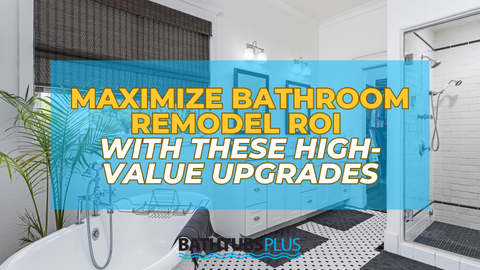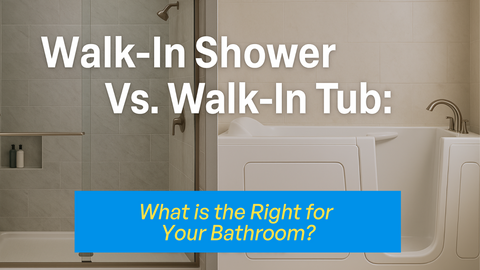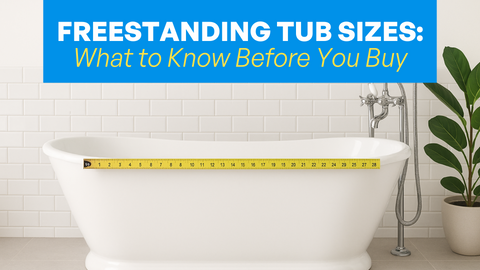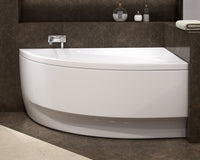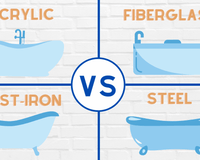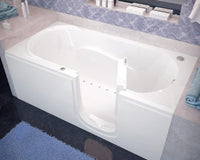Planning a bathroom redo? Choosing between a freestanding tub or built-in tub is a big call. Freestanding tubs are in vogue – they're stylish, come in various shapes, and make a splash in spa-like setups. But, let's not overlook built-ins. They snugly fit into smaller bathrooms, are practical, and a breeze to clean. We're into both at BathtubsPlus, but each suits different folks and spaces. This guide breaks down the pros and cons, helping you pick the tub that fits your vibe and needs.
Freestanding Tub vs. Built-in Tub: Pros and Cons
Freestanding Tubs
What is a freestanding tub?
A freestanding tub is a visually striking centerpiece for any bathroom, standing independently of surrounding walls and fixtures. Unlike traditional alcove baths, these tubs offer complete design freedom, allowing placement anywhere in a room as long as plumbing can be accommodated.
Whether opting for an antique cast iron clawfoot or a modern acrylic design, the tub's configuration can range from classic to contemporary, influencing the overall room aesthetic. Freestanding tubs come in various materials and can feature luxury options like having whirlpool or air jets
One of its common constraints is ensuring proper plumbing for water and drain lines. While choosing this bathtub may pose practical considerations, the aesthetic allure of a freestanding tub often makes it a captivating focal point in any bathroom.
Pros of a freestanding bathtub:
- Versatile Styles: Freestanding tubs offer a wide range of styles, from classic clawfoot designs to modern egg shapes, providing limitless options to fit any aesthetic.
- Aesthetic Appeal: Chosen for their unique and statement-making look, freestanding tubs are often associated with luxury, making them a popular choice for high-end spa atmospheres.
- Ease of Installation: Installing a freestanding tub is a straightforward process, typically requiring only a plumber, as opposed to the more complex installation often associated with built-in tubs.
- Flexible Placement: Unlike built-in tubs, freestanding tubs offer creative freedom in placement. Whether you desire a tub under a skylight in the middle of the room or another unconventional location, the flexibility of freestanding tubs allows for imaginative use of space.
- Showcases Tile: Lifted off the floor, freestanding tubs allow more of your bathroom tiles to be visible, highlighting your chosen tile design.
- Illusion of Extra Space: Despite using more room, these tubs create the illusion of a larger bathroom, thanks to the open area beneath, enhancing the sense of space.
-
Timeless Statement: Freestanding tubs make a timeless and enduring design statement, ensuring that your bathroom maintains a stylish and attractive appeal over the long term.
Cons of a freestanding bathtub:
Our freestanding tub recommendations:
1) Anzzi Sofi 5.6 ft. Center Drain Whirlpool and Air Garden Tub with Jets in White

Price: $1,410.99 | Buy here
2) Venzi Velia 34 x 71 x 21 Oval Freestanding Air & Whirlpool Water Jetted Bathtub

Price: $3,997.95 | Buy here
Built-in Tubs
What is a built-in tub?
A built-in tub is a smart and flexible bathtub designed to fit seamlessly into your bathroom. These tubs are made to balance space and your bathing needs, often coming with showerheads for a dual bathing and showering experience. They offer customization options like waterfall designs and detachable handshowers, making them adaptable to your preferences.
Whether you choose an undermount, drop-in, or alcove style, these tubs can be shaped to fit different spaces, making them practical and visually pleasing. Alcove tubs (a popular type of a built-in tub) which have three-sided walls and a front panel, are quite common and seamlessly blend into your bathroom's design.
Built-in tubs are loved for their functionality and the potential for attractive designs that can rival even freestanding tubs.
Pros of a built-in tub:
- Affordability: Generally more budget-friendly than freestanding tubs, especially considering the increased availability of cheaper options.
- Space Savings: Built-in tubs are space-efficient as they sit flush with walls, making them suitable for smaller bathrooms or alcove spaces that incorporate a shower.
- Ample Storage Options: Flush-mounted with walls, built-in tubs offer more storage possibilities. Shelves can be added on the walls beside the tub, and a sizable surround provides additional space for storage.
- Convenient Plumbing: Plumbing for built-in tubs is typically more straightforward, often utilizing existing bathroom plumbing. The plumbing is hidden beneath the tub, contributing to a neater appearance.
- Ease of Cleaning: Smaller and with fewer cracks and crevices, built-in tubs are easier to clean compared to freestanding or clawfoot tubs. Customization options, including jets and luxury settings, enhance the bathing experience.
- Combined Bathing and Showering: Built-in tubs can serve both bathing and showering purposes, eliminating the need for separate tubs and shower stalls, making them more convenient for a dual-purpose bathroom.
- Standardized Plumbing: Built-in tubs often have standardized plumbing requirements, making installation more affordable and streamlined.
- Customization: Built-in tubs offer the option for full customization, including the addition of jets, lighting, sound systems, and other luxury features.
- Shelving Integration: Shelving and storage can be seamlessly integrated around or near the built-in tub, providing convenient access to bath and shower products.
Cons of a built-in tub:
- Limited Placement Flexibility: Built-in tubs are less flexible in placement, often confined to the sides of the room or corner locations, restricting design options.
- Reduced Style Options: Built-in tubs have fewer style choices, relying on their surround for uniqueness. Compared to freestanding tubs, there's less creativity in the design of built-ins.
- Complex Installation: Installing built-in tubs involves sealing, mounting, and often creating a surround, making the process more intricate and potentially costlier than freestanding tubs.
- Aesthetic Appeal: While subjective, freestanding tubs often surpass built-ins in aesthetic appeal, making a more profound design statement.
- Challenges in Layout Changes: Removing a built-in bathtub can be difficult if you ever want to change your bathroom's layout, requiring more effort and potentially higher costs.
- Higher Maintenance Costs: Maintenance and repairs for built-in tubs may be more expensive compared to freestanding tubs.
- Restrictions on Placement: Built-in tubs must be placed against a wall, limiting placement options and preventing placement in the middle of the room.
- Lack of Clawfoot Option: The built-in tub style does not offer the iconic clawfoot design, limiting choices for those who prefer this classic look.
- Longer and Costlier Installation: The installation process for built-in tubs typically takes longer and can incur higher costs due to the need for plumbing and construction work.
Our built-in tub recommendations:
1) Venzi Villa 32 x 72 Rectangular Soaking Bathtub with Reversible Drain By Atlantis2) Venzi Flora 48 x 60 Rectangular Soaking Bathtub with Center Drain By Atlantis





